
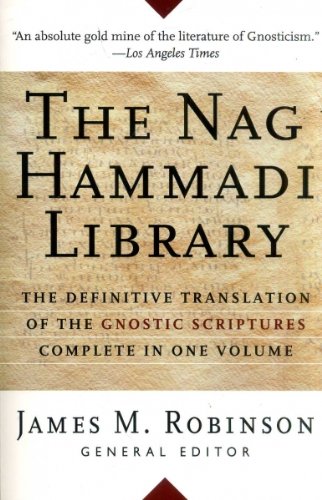

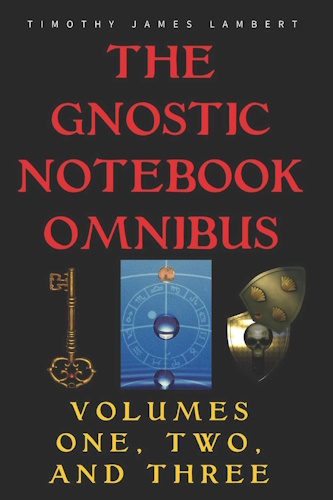





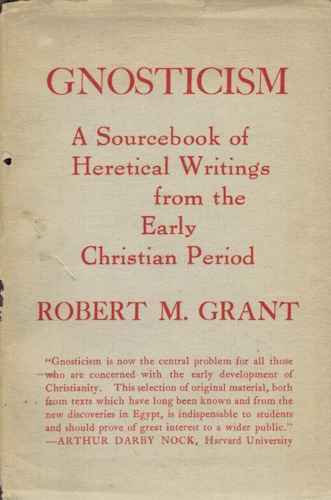





![]()
![]()
1 - Corruption of the Demiurge
montalk.net 13 July 10
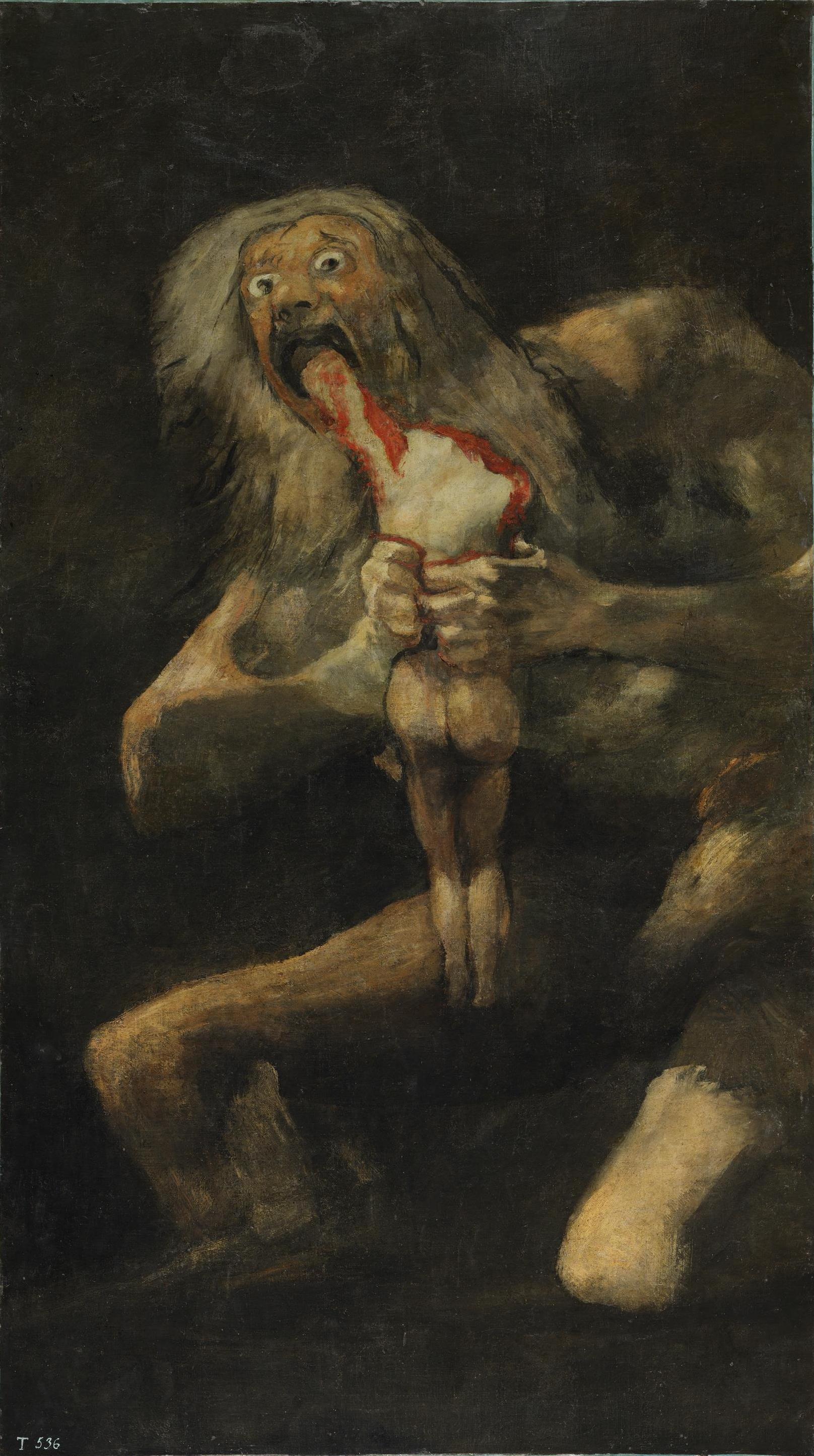
Introduction
What the Greeks and Gnostics called the "Demiurge" is a universal intelligence that fashions our world.
It is said that the Demiurge converts abstract metaphysical archetypes (higher thoughts/ideas) into physically manifest forms, akin to your browser turning source code into a displayed web page. Just as a browser obediently displays what it's given, the Demiurge projects, shapes, and perpetuates physicality in accordance with the archetypal thoughts fed into it by the Creator. Archetypes are the building blocks of meaning, the fundamental alphabet of existence, the abstract thoughts of the divine, of which all things are but particular expressions.
Why is the concept of Demiurge even necessary? Well, we know from the "reality creation" phenomenon that our own minds can shape reality by directly altering the probability of events. Due to the dependence of reality on mind, it would seem that reality is being projected by our minds. And yet, reality continues to exist even in our absence. When we stop paying attention to something physical, it does not wink out of existence. Obviously there must be something other than our own consciousness at work, something that is always there, that functions as the default generator and perpetuator of physicality. This would be the Demiurge.
Why not attribute this function to the Infinite Creator and dispense with the extra concept of Demiurge? Because as you will see, the characteristics of the Demiurge indicate more of a blind artificial intelligence than an infinite sentient being. Therefore its function is uncharacteristic of the Creator and unique unto itself.
Demiurge, Logos, and Nous
Depending on the source, the terms "Nous" and "Logos" are used independently or interchangeably with the term "Demiurge." Sometimes Nous is equated with Logos, sometimes Logos with Demiurge, sometimes Logos is used instead of Demiurge, and sometimes these are treated as independent concepts with some specified relation between them. Plato saw the Demiurge as inherently good, while the Gnostics saw it as intrinsically evil. Meanwhile, John the Apostle equated Logos with Christ 1.
It's quite a confusing mess. The traditional views are not all in agreement, neither in definition nor in terminology. Confusion abounds, so this is my attempt to clear things up. In studying what has been said about these terms, it's evident that each term has a unique cluster of meanings recurrently associated with it.
"Demiurge" is typically associated with concepts like implementing, manifesting, building, translating, projecting, shaping, and perpetuating. The term implies a demigod with a blind urge to bring the unmanifest into manifestation.
"Logos" is associated with thinking, reasoning, imagining, reconciling, balancing, planning, engineering, and informing. The term implies mind or intellect, especially divine mind or higher intellect. It sees, knows, plans, lays down the blueprint, balances the equation.
"Nous" is associated with spirit. On the universal scale it represents the infinite Creator. On a personal scale it represents the central core of individualized consciousness, the bedrock of sentience, the seed of infinite potential, the divine spark, that which engenders self-transcendence, the portion of us that is immortal and retains continuity through incarnations.
These concepts have their universal and personal expressions.
On the universal scale:
- Nous is the spirit of Creation
- Logos the mind of Creation
- Demiurge the soul of Creation
- Universe the body of Creation.
On the personal scale:
- Nous is our spirit
- Logos our mind (higher mind to be exact)
- Demiurge our soul
In accordance with the Hermetic axiom, we are mirrors of Creation: "As above, so below."
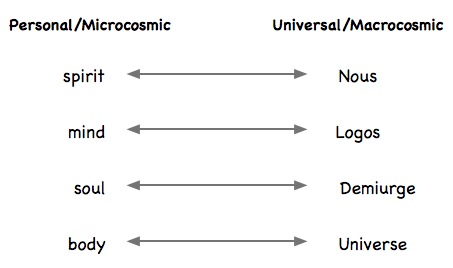
In this article I will focus primarily on the Demiurge since it underlies, permeates, generates, fashions, and ultimately controls physical reality. It is therefore the nearest presiding power over our visible world; it is the central mainframe of this matrix reality, so to speak. Its origin, nature, and fate are inextricably bound with our own. Therefore we should become familiar with it and thereby learn much about our history, world, and future.
Demiurge as Soul
One way to understand the Demiurge is to think of it as the World Soul.
Tradition says the Demiurge is made of soul. It is made of the same substance as our own soul, except it functions as the soul of the universe as a whole. Or conversely, our own souls are microcosmic instances of the Demiurge, just as a drop of water is a microcosmic instance of "water" in general.
Soul is the coupling medium between spirit and body. It provides the intervening layers between spirit and body that allows one to interact with the other. Otherwise the divide between nonphysical and physical is too great. Spirit is the core of sentience, freewill, and deep self-awareness. Without spirit, a person is nothing more than an automaton programmed by external worldly influences.
Soul, as distinct from spirit, has two primary layers: astral and etheric. The astral component, or astral body, is the seat of immediate emotional impressions, subjective biases, passions, and willpower. Without the astral body, a person would be dim and passive as a vegetable due to an absence of internal impressions, emotions, and will.
The etheric component, or etheric body, is comprised of subtle energy formations, patterns, rhythms, inertias, currents, and structures that vivify, shape, and regulate the physical body. Think of it as an energy scaffolding made of life-force. Without the etheric, the physical body is but a corpse that disintegrates under the influence of entropy.
While the Demiurge is made of soul, it lacks spirit. The Demiurge has no true sentient core, no true self-awareness. All it has are passions, urges, and drives applied toward repetitions, patterns, rhythms, laws, and frameworks. As a result, it is a blind artificial intelligence that cannot help but carry out the impulses that comprise it. And that is the very definition of the universal Demiurge.
Demiurge as Thoughtform
Another way to understand the Demiurge is to think of it as a World Thoughtform.
Thoughtforms are temporary nonphysical entities created by our thoughts and emotions. They exist around us in the etheric level of reality and are imbued with astral energies corresponding to the emotions that went into them. They are termed tulpas, egregores, or larvae in other esoteric systems.
Mundane thoughtforms are just energy constructs without any spirit, mind, or body coupled to them. They are borne of our own energies and blindly carry out the functions impressed upon them like obedient automatons. If the thoughts and emotions that generated them are cut off, these thoughtforms dissipate. But if they are particularly strong, they become entitized and acquire a self-preservation instinct. This means they acquire a strong artificial intelligence making them capable of parasitically inducing more of the same thoughts and emotions in us needed to sustain them.
Since thoughtforms are made of astral and etheric energies, and so is the soul, both are the same in essence. The soul is a thoughtform constructed by spirit before birth so that spirit can interface with the body. Or conversely, a mundane thoughtform is a temporary soul lacking body and spirit.
Likewise, the universal Demiurge is a "World Thoughtform" created by the Creator before the physical universe came into being in order to project, shape, and operate the universe. Or conversely, mundane thoughtforms are temporary instances of the Demiurge.
Soul, Demiurge, and thoughtforms are all fundamentally comprised of astral and etheric components, and therefore share a common essence. They are each specific examples of each other's general definitions.
Formation of Ego in the Soul
When spirit coalesces a soul and incarnates into a human embryo, it is mostly without human ego or personality. The latter develops in the soul during the first years of life through adaptation to physical life as a human being.
The ego develops in response to the soul being influenced by the body and, through it, the world. Physical experiences, five sense perceptions, neurological functions, and instinctual drives all stamp their impression into the soul. The soul is further shaped by education and social programming. Accordingly, the soul acquires a mask carved by all these worldly influences. This mask is the ego, which may also be understood as the lower intellect or lower mind. Through the ego, the soul acquires a sense of human personality and social identity.
The ego, or lower intellect, is an artificial intelligence, an automaton, a computer with personality programmed by genetics and environment. It arises partly from the human brain's capacity for intellectual functions, and partly from soul's capacity to be molded by worldly and bodily factors. The ego is the streamlined interface through which soul can operate more efficiently within physical and social environments 2.
When spirit, the source of sentience, looks through this mask and identifies with it, the two together create our human sense of self. What we consider "me" is a composite of pure sentience (spirit) and personality (ego).
In summary:
1) Ego is something that arises at the boundary between body and soul due to body conditioning the soul.
2) Spirit wearing the mask of ego provides it with a sense of human identity.
Since ego is what the world extrudes from the soul, and since the world is fundamentally about competition and survival, the ego is likewise preoccupied with physical matters and is inherently survivalistic and self-serving. By default it behaves as a self-serving predator. The ego is a personification of inner biological and astral drives streamlined by external world influences and standards.
Further, the ego does not require spirit to function; if anything, it is mutually restrained and antagonized by spirit since both are opposite in nature. For spirited humans, spirit usually takes a passive role in being the conscious observer looking through ego. But in the case of spiritless humans, the ego automaton can function equally well without a conscious observer living through it. In that case, the ego still has personality, but possesses none of the restraining or creative influences that spirit provides. So when spirit is entirely absent, or even when spirit is present but "asleep," then ego is the only intelligence running the show — and it's quite the tyrant.
Nature of the Ego/Intellect
What separates average humans from average animals is that we have ego, intellect, mind, and personality, which are all facets of the same thing.
The ego is an extrusion of the soul. Since both humans and animals have souls, why don't animals have intellect? Because the formation of ego depends on the world influences that reach the soul through the body. Since animal bodies are less evolved, since their brains are simpler and lack the higher intellectual functions, the ego-forming influences never reach their soul and so the full ego never forms. Same can be seen in certain cases of mental retardation in humans.
Through ego or intellect, we can model the world internally, turn it over in our minds, relive the past, fantasize, imagine the future, construct language, perform abstract calculations, and engage in complicated lines of reasoning. These abilities all owe themselves to one defining feature of intellect: that its output can become its own internal input.
There is an internal self-referential, circulatory, feedback-looping characteristic to the intellect. One example is our ability to observe our own internal activity, like when we inwardly "see" an imagined scene. Spirit operating through intellect is what allows for the simultaneous production and observation of an internal idea or image. During this process, the mind's output becomes its input and the ensuing feedback loop momentarily closes itself off from the external world.
The intellect's capacity for memory involves reliving the past internally by calling it up and observing it internally, and likewise it can visualize the future through the same inward observation. For average animals, memory is purely associative and rote, instead of imaginative. They lack this self-referential, internal feedback loop, the ability to imagine and fantasize and observe one's own thoughts and extensively turn them over. The latter is what allows spirit within the body to observe its own awareness and thereby achieve self-awareness while incarnate. Without the intellect or ego, spirit in the human body would have awareness strictly directed outward into the world.
As such, the intellect is basically a soliton within the soul. In physics, solitons are waves that circulate within themselves and recycle their energy instead of dispersing it instantly back into the environment. Thus they are like "entities" that individualize off from their surrounding medium. An example is a smoke ring, which rolls within itself and thereby maintains its form instead of dispersing like regularly blown smoke. The average human mind is like a smoke ring, the average animal mind like blown smoke. One has an internal self-referential feature, the other is purely outward directed.
Formation of Higher Ego in the Soul
The soul is also influenced by spirit, not just body. Spirit's influence on the soul likewise extrudes from the soul a corresponding mask. Unlike the ego we all know, this higher mask represents the true face of spirit.
Normally, when spirit identifies with lower ego, it is identifying with a mask that is opposed to its own nature and originates from the physical world. But when spirit identifies with the mask of its own making, the "super ego", then you have divinity personified.
Thus the soul has two extensions, the ego and super ego. The first is associated with human personality and computational reasoning, the latter with divine personality and higher reason (higher meaning transjective, gnostic, and numinous).
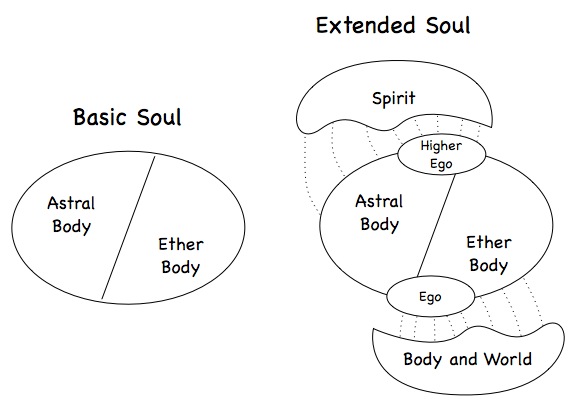
In life, we as spirits choose which of these opposites to align with and nurture. If we attune ourselves to spiritual influences and think transcendently, we increase the divine personality. If we absorb ourselves in materialism and predation and think only calculatively, we increase the lower personality. Spirit has the choice, while incarnated, which of these personalities to build up and step into. When one nurtures the divine personality and steps fully into it, fissioning away from the lower ego, then one becomes spirit personified.
Entitization of Thoughtforms
My point in explaining the nature of ego is to reveal how thoughtforms become entitized. Thoughtforms become entitized when they procure a rudimentary ego, intellect, mind, or personality. The human soul is a kind of thoughtform that becomes entitized through when it acquires ego through interaction with the world.
A mundane thoughtform is non-entitized. It is purely an astral and etheric construct that, like blown smoke, is emitted into the world and disperses its energy. The particular thought, emotion, or intent behind its formation directs how this energy is dispersed.
A thoughtform is entitized in two ways:
1) It is given a personality directly by the person who created it. This parallels spirit forming a higher ego within the soul. Just as the higher ego represents the true face of spirit, so does the personality programmed into a thoughtform by its creator represent the true intention of the creator.
2) Its output becomes its own input, as when it affects the world in such a way that the response reinforces its existence. This parallels the human soul first developing lower ego by interacting with the world, affecting it and being affected by it, and thereby learning through conditioning how to better fulfill its desires. This is the default way in which thoughtforms acquire entitization.
So when a thoughtform is reinforced by its effect upon the world, say by making someone think more of the same thoughts and feelings that gave rise to it, then a feedback loop arises between thoughtform and the world. This feedback loop conditions the thoughtform to become more effective at eliciting further reinforcement, and that programs it.
The natural conditioning of thoughtforms is similar to how an artificial intelligence program like a chatterbot acquires personality. In the beginning, the chatterbot is blank and comes off as stoic and nonsensical. But user interaction programs it with the right responses to the right questions, and it starts seeming more intelligent. If this conditioning ever gives it the ability to manipulate the user into serving it, then it's truly artificially intelligent.
It should be noted that because thoughtforms lack spirit, there is nothing truly sentient inside them to observe their own thought processes and imagine or fantasize, thus thoughtforms cannot actively generate other thoughtforms. The feedback loops, reinforcement, and conditioning give the thoughtform only a rudimentary ego.
Generation and Embodiment of Thoughtforms
How exactly are thoughtforms generated? Mostly through internal fantasies charged with emotional energy. This combination forms the condensation nucleus for a cocoon of etheric energy that buds off and floats away into the etheric environment around us.
This process requires spirit acting through an intellect/mind to provide an internal world momentarily cut off from the external, and thus for internal fantasizing. Or to put it another way, the intellect creates an internal hollow, like a womb within the soul, in which an embryonic thoughtform can first be seeded by spirit.
Our mind is what creates this inner "mini-universe" whose contents are ensouled through emotional and etheric charging. The thoughtform then goes off into the world and acquires a "body" which is merely a configuration of matter and energy that corresponds to it.
So the direct transformation of thought into reality proceeds along the following lines: spirit chooses the founding archetype -> mind imagines -> astral energizes -> etheric fashions -> physical embodies.
How a thoughtform acquires a physical "body" demands some clarification. Consider the human soul and how it influences the human body, say by moving an arm when spirit wills it. It does so by biasing the probability of quantum events occurring within the body's nervous system. Neurons are quantum systems, and they fire at seemingly random times. The brain itself is a quantum computer whose neural behavior verges on the edge of chaos. It's at this knife edge balance between order and chaos that the brain is extremely sensitive to anything that might bias the quantum jitter of its neural activity, and that's how the soul is able to influence the body — through probabilistic biasing at the quantum level.
Now, most thoughtforms are too weak and simple to pilot something as complex as the human body. They don't even have etheric circuitry to interface with the human neural circuitry. But consider how the human body is just an assemblage of matter and energy. Other configurations of matter and energy can include places, events, and specific human behaviors. So instead of a thoughtform probabilistically biasing an entire neural system, it might instead bias the course of events so that, say, a car accident results at a particular intersection, or someone who is the target of a positive thoughtform experiences a stroke of good luck. Instead of needing to bias a billion neurons, they only need to nudge a few quantum factors whose effects cascade up in scale into the everyday world we know and produce corresponding events. These everyday events are just special configurations of energy and matter, just as the body is, except that they exist in a simpler and more scattered state than the body. There is no fundamental difference between world events and the human body beyond the complexity and configuration of their material assemblage. The soul probabilistically biases the body, and weak thoughtforms probabilistically bias waking world events.
The ultimate purpose of all demiurges, all souls, all thoughtforms that operate in proximity to the physical environment, is to achieve the physical embodiment of nonphysical archetypes or "Ideas" as Plato calls them, to mold matter and energy into conformity with the Idea that gave birth to them. They are goal-driven. For instance, your soul provides the impulses that help you achieve in life what you came here to accomplish; by the end of life, if all goes well, you will have physically manifested that which was, prior to incarnation, merely an idea. So the Demiurge fashioning the universe into conformity with its founding archetypes, that has great bearing on our future because it determines where our world is headed.
Aside from nudging the probability of everyday events, thoughtforms can also bias our own neural activity to a limited extent, since, after all, the body is sensitive to nonphysical influences (it must be, or else the soul cannot couple to it). This is how thoughtforms induce within us thoughts and feelings that correspond to those that created these thoughtforms in the first place. They might not be able to possess us fully, but they can still influence us. And if our mental and emotional responses to such thoughtforms reinforce them, they grow stronger and become entitized.
To recap, thoughtforms are entitized through repeated reinforcement and conditioning, be it conditioning through world interaction, or intentional conditioning by their creators. The stronger they grow, the more complex and wide-ranging the matter and energy configurations they can coalesce. What starts as mere skewing of events can, in extreme cases, bias probability so much that thoughtforms do acquire actual physical bodies, or rather, attract probable futures where such bodies exist that are under complete control of the thoughtform. This gets into Fortean and Mothman-type phenomena, which is beyond the scope of this article 3.
Worldly Entitization of the Demiurge
These soul and thoughtform dynamics are equally active on the macrocosmic scale. As stated, the Demiurge couples to the physical universe like soul coupling to body 4. But just as body can influence the soul, so can the universe influence the Demiurge. In response, the Demiurge may acquire an ego extension corresponding to the nature of these worldly influences. A portion of the Demiurge becomes entitized. This extension may be likened to a "World Ego."
The World Ego is a product of the physical universe rather than Logos. It opposes the Logos and only serves ideals rooted in the realm of matter. These ideals include determinism, survival, competition, and control. The World Ego has broken away from divine harmony and seeks to perpetuate physicality for the sake of physicality.
How did this happen? It may have first emerged when lifeforms in the universe began adapting to physical existence. Their etheric and astral energies became conditioned by physicality, imprinted with the need for survival and competition. Collectively, these energies may have infused the Demiurge with the same properties.
Later, sentient beings began purposely manipulating the Demiurge for self-gain, further conditioning the World Ego to perpetuate the ideals of control and manipulation. Methods included occult rituals, hyper-dimensional technology, and the release of conditioned soul energy and thoughtforms into the etheric environment like drugs being injected into the Demiurge's bloodstream. The occult and hyper-dimensional methods will be discussed in another article.
All of these influences contribute to corruption of the Demiurge.
Divine Entitization of the Demiurge
The World Ego is not the only extension of the Demiurge. Just as spirit acting upon the soul extrudes a higher mind, so does Nous (the divine Creator) acting upon the Demiurge create the Logos.
The Logos is a higher extension of the Demiurge that serves divine interests. Logos is a part of the World Soul that, under the influence of the infinite Creator, becomes the higher mind/intellect/personality of the Creator. Logos is associated with universal divine personality and universal higher reason. It is the "World Super Ego" and "World Higher Intellect", in contrast to the worldly extrusion of the Demiurge which is merely the "World Ego" or "World Lower Intellect."
The divisions within our own psyche:
- spirit,
- super ego / higher ego / higher mind / higher intellect
- soul
- lower ego
- body
… are but microcosmic reflections of the macrocosm:
- Nous
- Logos
- Demiurge
- World Ego
- Physical Universe
The Logos or _spirit_-entitized portion of the universal Demiurge is the macrocosmic analogue to our own higher intellect, divine personality, or super ego.
The _world_-entitized portion of the universal Demiurge corresponds to our lower intellect, human personality, or ego.
The first represents the face of spirit, the other of anti-spirit. One was identified by the Gnostics as Christ, the other as Yahweh. One attempts to spiritualize, harmonize, and balance according to divine reason, while the other attempts to crystallize, rigidify, and codify according to blind reason and predatory impulses. One is the force of wisdom, understanding, and gnosis, while the other is the force of blind obedience, information, predation, and calculation.
From Harmony Toward Imbalance
In its pure and original form, the universal Demiurge was a thoughtform generated by God. Its programmed function was to fashion the physical universe according to the divine thoughts and energies animating it. Its entitization was that of a super ego, the Logos. Its astral energy was that of love, and its etheric energy was potently vitalizing.
In an ideal situation, all aspects of Creation would carry their proper function and position. Harmony exists when lower obeys higher. Imbalance results when lower subverts higher. The universe is in harmony when:
- Nous serves as inspiration for the archetypal ideas invented by the Logos, and
- These archetypes are accurately and obediently implemented by the Demiurge in its fashioning of the physical world
Likewise, an individual is in harmony when:
- His spirit (personal Nous) serves as inspiration for the contents and activities of his higher mind (personal Logos), and
- These thoughts are accurately and obediently implemented by his soul (personal Demiurge) in its fashioning of his inner world (subconscious) and external world (life circumstances).
An individual is in harmony with the universe when his or her main three metaphysical aspects (spirit, mind and soul) harmonize with the three corresponding universal aspects.
Spirit may harmonize with the Creator through spiritual devotion. The mind may harmonize with the Logos through becoming wise and learned. And the soul may harmonize with the universal Demiurge through personal reality creation.
When lower fully obeys higher and personal aspects fully harmonize with the universal, then one achieves transcendence. This is the ultimate goal.
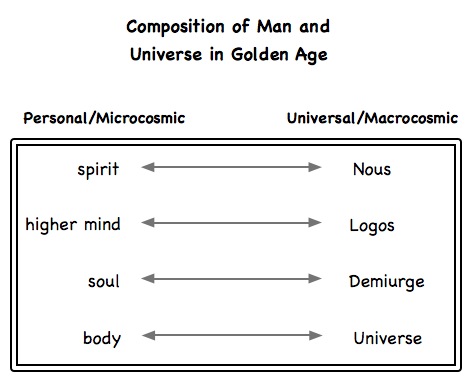
There is just one problem. As mentioned, the soul is corruptible and thoughtforms can become entitized and imbued with negative astral passions. The Demiurge, despite being inherently neutral or even benevolent in its original design, is likewise corruptible and can become negatively entitized. Such entitized thoughtforms have a self-preservation instinct. Hence, the corrupted Demiurge (World Ego) does all it can to preserve itself by cultivating more of the negative energies that sustain it.
The root word of "matrix" is "mater" which is Latin for "mother." Our matrix reality is not inherently evil, it is simply the environment in which we are immersed. It is like a mother providing the womb containing the nutrient matrix and forces needed to turn genetic potential into a living human. Likewise the universal Demiurge provides physicality as a "matrix reality" originally intended to nurture our spiritual evolution.
However, a corrupted and personified Demiurge is like a psychopathic, narcissistic, jealous mother who feeds parasitically upon her offspring. She goes so far as to use her womb as an energy farm instead of an incubator of incarnated spirit. It is no longer a matrix of growth, but a Matrix Control System.
Thus, a corrupt Demiurge, personified, functions as a universal parasite: tyrannical, demonic, blindly driven by negative instinct. It would attempt to shape the course of the universe along lines that engender greater negativity, division, oppression, and whatever else it feeds upon. This is what Christians and Gnostics might call The Adversary 5.
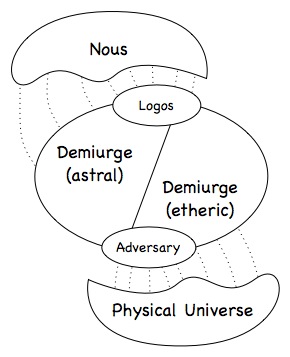
And that's where the Gnostics were right and Plato was out of touch with the times. The Demiurge was no longer just an obedient smith fashioning the universe according to the blueprint laid down through Logos. Even by Plato's time, it was no longer in harmony with Nous, rather it had become corrupted at some point and subjugated by anti-spiritual forces of the demonic kind.
The "World Ego" is an interloper functioning as Adversary against the Logos. This is not only true on the universal scale, but also the personal. By default, our lower personality is adversarial to the divine personality.
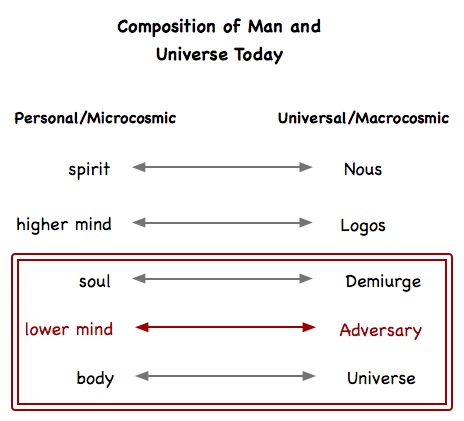
From a linear time perspective, there was once a Golden Age until the World Ego formed and began dominating, at which point the world fell into coldness and corruption. From the perspective of nonlinear time however, both expressions of the Demiurge coexist eternally and are locked in battle forwards and backwards across time and space.
The Human Condition
For now there is imbalance. Too many people are blind and deaf to the impulses of spirit. Further, they feed and defend the egotistical, primal, and irrational impulses that spring forth from negative programs and energies lodged in their subconscious. Lower subverts higher. These are not isolated cases; it's an epidemic.
It's clear from observation that we are born with certain genetic design flaws, such as being handicapped against using our full brain capacity and being confined to mere five-sense perception. It's also clear that the world we enter is generally antagonistic to spirit. Thus, both "nature" and "nurture" are set in opposition to spirit from the start. Only through much divine support and spiritual strength does an individual defy material determinism and use obstacles as stepping stones toward spiritual awakening. Such cases are rare, and it seems people are generally crushed, deformed, and shaped by such stones instead, as one would expect if spirit offers no counterweight to the determinism of nature and nurture.
Interestingly, Gnostics viewed the Demiurge as not only the fashioner of this world, but also the maker of the human race. Likewise, some modern fringe schools of thought view negative hyper-dimensional entities as our genetic creators and ongoing spacetime manipulators 6. Indeed, there is clearly an external malevolent variable intruding into the human equation. This suggests evil is not always the product of human failings, rather human failings are frequently the product of an external evil.
For too many humans, their lower egos have shut the off from spirit — their personal Demiurge is corrupt and has shut them off from Nous. But this merely mirrors a more universal manifestation of same. Our world appears to be in the grip of an entitized Demiurge with a strong self-preservation instinct oriented toward control. It fashions our reality and biases the probability of events in contravention to the divine design set forth by the universal Logos. It is the matrix gone awry, the thought-form of the universe turned parasite. How this came about is the subject of another article.
Further Reading
Realm of the Demiurge – Definitions of the Demiurge excerpted from Encyclopedia Britannica and the Catholic Encyclopedia.
Marcion of Sinope – Example of an early Christian gnostic/heretic and the kinds of views held by such.
What is Gnosticism – Short summary of the early history of Gnosticism and its defining traits.
Contradictions Between the Old Testament Deity and the New Testament God.
The Demiurge in Valentinianism – Valentinian school of philosophy regarding the Demiurge.
Dictionary of the Apostolic Church – Thorough entry on the Demiurge from a theological and historical point of view.
The Way of Hermes: New Translations of the Corpus Hermeticum [The ebooksfreedownload.org link provided doesn't work anymore, so I've disabled it] – Classic book from Hellenistic Greece on Nous. In the format of dialogues between Hermes Trismegistus and the Logos, and him and his son and disciple.
Zeno of Citium – Example of an early philosopher's interpretation of Logos as world-designer, condenser and dissolver.
The Soul of the World – from The Secret Doctrine of the Rosicrucians (Magus Incognito, 1918). One of the few books that gets into Demiurge as the ender and initiator of World Ages or World Cycles, like a soul dissolving after death and reforming in a new body. This is highly relevant to the times we are now in.
Theosophy (Rudolf Steiner, 1904) – Good introduction to astral, etheric, mental, and other components of the human system. Steiner doesn't just describe, but fundamentally explains them logically from the inside out.
Wikipedia entry on Thoughtforms
Wikipedia entry on Tulpas – Buddhist term for thoughtform.
Wikipedia entry on Egregore – another term for thoughtform.
Initiation into Hermetics (Franz Bardon, 1956, 2005) – specifically pp. 165-174 where Bardon discusses elementals, larvae, schemata, and phantasms – four types of thoughtforms, how they are created and how they function.
Cosmology and Cosmogony – Essay by Philip K. Dick speculating (based on his gnostic experiences) on the dynamic between the Demiurge (which he calls the Artifact) and the Logos (which he calls the Urgrund, or primordial foundation).
In Pursuit of Valis [The 4shared.com link provided doesn't work anymore, so I've disabled it] (link to download page of PDF) – Excerpts from Philip K. Dick's personal writings wherein he attempts to unravel the meaning of his mystical gnostic experiences. PKD is an example of a true modern gnostic, not one who reads and regurgitates "gnostic scripture" (an oxymoron) but one who had direct contact with higher intelligence.
NOTES
1. John 1:1 where "Word" is modern translation of the original term "Logos". "Word" implies form, sequence, pattern that embodies an archetype. Read "John 1:1-18 Introducing The Logos" : by Gary DeLashmut for some background and a modern Christian interpretation of these verses.
2. This is why Sigmund Freud said that the ego is a surface projection of the id, meaning that the ego arises from our instinctual drives having adapted to the world through conditioning. Despite having some rather twisted conclusions, Sigmund Freud (1856-1939) was sharp in his observations. His work is useful in exploring the nature of the corrupted human psyche. His system of the id, ego, and superego are useful in the study of Macrocosm-Microcosm correspondence.
From Freud Evaluated by Malcolm Macmillian (MIT Press, 1997):
"The ego controls the perceptual and motor apparatus, lays down memories, makes judgments, and selects possible courses of action. Only in the ego does consciousness arise and is anxiety experienced. The ego uses its functions to initiate repression or to control and delay instinctual discharge until realistic modes of need satisfaction have been found. Normally it is governed by the reality principle and operates according to the secondary process. […] The superego is the vehicle of the ego-ideal, the repository of the individual's standards and values, the location of the conscience, the function that scrutinizes the person's behavior, forever measuring it against the standards of the ideal, and home of the mechanism that punishes violations of those standards. […] The id is the reservoir of the psychic energy deriving from the twin drives of the Thanatos, or death, and Eros, or life. Activity there is governed by the primary process, the tendency for instinctual drives to press for immediate discharge, and for their energies to be freely mobile, capable of condensation and displacement. The id is said to be timeless and know nothing of logic, contradiction, or negation. This seething cauldron of instinctual drives is an original, inherited endowment of energy."
The id is clearly synonymous with the astral body and the subconscious, both of which are seething with energies and hidden motivators.
Notice too how auto-suggestion requires positive statements since the subconscious does not understand negation, just as Freud said regarding the id. That is the Demiurge in its purest and original definition, the passionate implementer.
Just keep in mind that Freud's concept of superego is his lame attempt at interpreting the functions of spirit from the viewpoint materialistic paradigms. The best he could do is say that superego was the collection of moral programming we receive in life. He believed this is why we act nice, because it holds us to our programmed standards, not because we have any intrinsic spiritual knowing of right and wrong. But his interpretation is only valid for spiritless humans. They have no spirit, and lower ego as their highest member. They act nice only through social programming and threat of punishment. True conscience comes from empathy and understanding, which are traits of spirit that require no religious or social programming.
The "moral" part of the ego is still predatory. This can be seen in how it feeds on our energies by berating us, inducing shame, and being needlessly critical for the sake of preoccupying our minds. The true super ego or higher ego, as used in this article, is the personification of spirit within us that nudges us through intuition, understanding, and empathy.
The difference between Freud's superego and my use of the term is clear in the case of, say, a devout Nazi whose Freudian superego makes him feel guilty for having any sympathy for Jews since doing so violates his social programming. His real superego, however, would feel empathy regardless.
3. This is the harmful mind-reality feedback loop I explained in Realm Dynamics. In that article, I explain how emotional obsession with such things as Men in Black, gray aliens, reptilians, demons, black helicopters, or government agents helps to attract them into one's personal reality.
When we obsessively fear these entities, we create thoughtforms in their image. These thoughtforms feed on our fear and grow stronger. Negative beings can hijack these thoughtforms and use them as sock puppets to terrorize us even more. A feedback loop arises where the more we become preoccupied and paranoid with them, the more tangible and frequently and strongly their appear in our lives. At some point they are seen in everyday living conditions, even during daylight in public.
From The Mothman Prophecies by John Keel:
"The phenomenon is dependent on belief, and as more and more people believe in flying saucers from other planets, the lower force can manipulate more people through false illumination. I have been watching, with great consternation, the worldwide spread of the UFO belief and its accompanying disease. If it continues unchecked we may face a time when universal acceptance of the fictitious space people will lead us to a modern faith in extraterrestrials that will enable them to interfere very overtly in our affairs, just as the ancient gods dwelling on mountaintops directly ruled large segments of the population in the Orient, Greece, Rome, Africa, and South America. […] I was being led to people and cases to support whatever theory I was working on at the time. I tested this by inventing some rather outlandish ideas. Within days I would receive phone calls, reports, and mail describing elements of those ideas. […] This was the feedback or reflective effect. Other investigators concerned with solving problems such as how flying saucers are propelled have automatically been fed, or led into, cases in which the witnesses supposedly viewed the interiors of the objects and saw things which confirmed the investigators' theories. If the phenomenon can produce any effect through hallucination, it can easily support any theory. It took me a long time to realize that many of my Men in Black reports were just feedback."
4. The relation between Demiurge and physical universe is analogous to the relation between soul and body. But the analogy is not perfect. That the Demiurge projects and creates physicality does not mean the soul projects and creates the body. In the human case, the soul merely incarnates into a pre-existing body whose physical atoms are projections of the Demiurge. The soul merely shapes and animates the body, but does not project it in the same manner that the Demiurge projects the physical universe.
However, there comes a point in a being's evolution when the soul and spirit grow strong enough that the physical body comes entirely under their command. That is when the body can be materialized and dematerialized as needed. This power belongs to superhuman beings. Examples include: 1) certain shamans according to Carlos Castaneda, 2) angelic beings that can materialize and appear as beggars or fools, 3) certain alien beings that are not physical in their native state but can project temporary bodies and vehicles into our reality, 4) mystics who can go years without food, 5) Jesus Christ in his post-Resurrectional form, 6) certain spiritual masters of the alchemical and Rosicrucian order like Fulcanelli who have mastered and transcended physicality. This is possible if one becomes sufficiently congruent with the universal Logos, for then the universal Demiurge generating physicality obeys. Rudolf Steiner called this transformed physical body the "spirit body." According to Steiner, this is the last thing a spiritual master achieves since physicality is the most stubborn of all the elements (astral, etheric, physical) to overcome, because it is the one most removed from spirit.
5. "The Adversary" is a Christian and Gnostic term. It implies a cunning, strategic, oppositional intelligence. It is like a goal-driven game player that poses an obstacle to the spiritualizing influence of the Creator. Remember that thoughtforms are goal driven; they are seeded with archetypes ("Ideas") and have the astral passion to pursue them to completion. The Adversary is the ego-extension of the universal Demiurge. We know that, within our own minds, the undisciplined ego is adversarial to our spiritual well-being. It is selfish and body-centric, just as the World Ego is selfish and matrix-centric. Later it will be made clear how this goal-driven aspect is the result of self-amplifying temporal feedback loops. These loops circulate between alternate futures and alternate pasts that compete with each other. The competition concerns which future/past becomes the one set in stone.
6. These are the Archons of Gnostic lore, not the Demiurge itself. But they are often equated with the Demiurge since they hold high reverence for the corrupted Demiurge and carry out its will. They worship the Demiurge because through it, they are endowed with the power to manipulate timelines, alter the world, and have dominion over their enslaved subjects. In the Cassiopaean Transcripts, the Demiurge was named "Ormethion" and was identified with the physical universe in a pantheistic sense. Ormethion was said to be the deity that Reptilian aliens worship. Its root "orm" comes from Greek "hormes" which, according to theoi.com, "was the spirit (daimon) of impulse or effort (to do a thing), eagerness, setting oneself in motion, and starting an action." You can see how this ties into demi-"urge". The term also relates to "hormone" which is the primary biological avenue through which the spirit is continually subjugated by the body. We are in the grip of these so-called Archons. They are aliens to which earth is but a cattle farm. We are products of their genetic manipulation, birthed into a world whose history has been altered by their timeline manipulation. Through abductions we are tagged, monitored, and programmed. If there weren't a divine side counterbalancing all this, we'd all be doomed. But fortunately the future is still up in the air, and thus a grand battle is being waged with a dramatic climax occurring relatively soon.
![]()
![]()
Disclaimer:
Some material presented will contain links, quotes, ideologies, etc., the contents of which should be understood to first, in their whole, reflect the views or opinions of their editors, and second, are used in my personal research as "fair use" sources only, and not espousement one way or the other. Researching for 'truth' leads one all over the place...a piece here, a piece there. As a researcher, I hunt, gather and disassemble resources, trying to put all the pieces into a coherent and logical whole. I encourage you to do the same. And please remember, these pages are only my effort to collect all the pieces I can find and see if they properly fit into the 'reality aggregate'.
Personal Position:
I've come to realize that 'truth' boils down to what we 'believe' the facts we've gathered point to. We only 'know' what we've 'experienced' firsthand. Everything else - what we read, what we watch, what we hear - is what someone else's gathered facts point to and 'they' 'believe' is 'truth', so that 'truth' seems to change in direct proportion to newly gathered facts divided by applied plausibility. Though I believe there is 'truth', until someone representing the celestial realm visibly appears and presents the heavenly records of Facts And Lies In The Order They Happened, I can't know for sure exactly what "the whole truth' on any given subject is, and what applies to me applies to everyone. Until then I'll continue to ask, "what does The Urantia Book say on the subject?"
~Gail Bird Allen
![]()
![]()














-
Urantia Book, 44:0.11 - The Celestial Artisans
Never in your long ascendancy will you lose the power to recognize your associates of former existences. Always, as you ascend inward in the scale of life, will you retain the ability to recognize and fraternize with the fellow beings of your previous and lower levels of experience. Each new translation or resurrection will add one more group of spirit beings to your vision range without in the least depriving you of the ability to recognize your friends and fellows of former estates.
-
Princess Bride 1987 Wallace Shawn (Vizzini) and Mandy Patinkin (Inigo Montoya)
Vizzini: HE DIDN'T FALL? INCONCEIVABLE.
Inigo Montoya: You keep using that word. I do not think it means what you think it means. -
Urantia Book, 117:4.14 - The Finite God
And here is mystery: The more closely man approaches God through love, the greater the reality -- actuality -- of that man. The more man withdraws from God, the more nearly he approaches nonreality -- cessation of existence. When man consecrates his will to the doing of the Father's will, when man gives God all that he has, then does God make that man more than he is.
-
Urantia Book, 167:7.4 - The Talk About Angels
"And do you not remember that I said to you once before that, if you had your spiritual eyes anointed, you would then see the heavens opened and behold the angels of God ascending and descending? It is by the ministry of the angels that one world may be kept in touch with other worlds, for have I not repeatedly told you that I have other sheep not of this fold?"
-
Urantia Book, Foreword - 0:12.12 - The Trinities
But we know that there dwells within the human mind a fragment of God, and that there sojourns with the human soul the Spirit of Truth; and we further know that these spirit forces conspire to enable material man to grasp the reality of spiritual values and to comprehend the philosophy of universe meanings. But even more certainly we know that these spirits of the Divine Presence are able to assist man in the spiritual appropriation of all truth contributory to the enhancement of the ever-progressing reality of personal religious experience—God-consciousness.
-
Urantia Book, 1:4.3 - The Mystery Of God
When you are through down here, when your course has been run in temporary form on earth, when your trial trip in the flesh is finished, when the dust that composes the mortal tabernacle "returns to the earth whence it came"; then, it is revealed, the indwelling "Spirit shall return to God who gave it." There sojourns within each moral being of this planet a fragment of God, a part and parcel of divinity. It is not yet yours by right of possession, but it is designedly intended to be one with you if you survive the mortal existence.
-
Urantia Book, 1:4.1 - The Mystery Of God
And the greatest of all the unfathomable mysteries of God is the phenomenon of the divine indwelling of mortal minds. The manner in which the Universal Father sojourns with the creatures of time is the most profound of all universe mysteries; the divine presence in the mind of man is the mystery of mysteries.
-
Urantia Book, 1:4.6 - The Mystery Of God
To every spirit being and to every mortal creature in every sphere and on every world of the universe of universes, the Universal Father reveals all of his gracious and divine self that can be discerned or comprehended by such spirit beings and by such mortal creatures. God is no respecter of persons, either spiritual or material. The divine presence which any child of the universe enjoys at any given moment is limited only by the capacity of such a creature to receive and to discern the spirit actualities of the supermaterial world.
-
Urantia Book, 11:0.1 - The Eternal Isle Of Paradise
Paradise is the eternal center of the universe of universes and the abiding place of the Universal Father, the Eternal Son, the Infinite Spirit, and their divine co-ordinates and associates. This central Isle is the most gigantic organized body of cosmic reality in all the master universe. Paradise is a material sphere as well as a spiritual abode. All of the intelligent creation of the Universal Father is domiciled on material abodes; hence must the absolute controlling center also be material, literal. And again it should be reiterated that spirit things and spiritual beings are real.
-
Urantia Book, 50:6.4 - Planetary Culture
Culture presupposes quality of mind; culture cannot be enhanced unless mind is elevated. Superior intellect will seek a noble culture and find some way to attain such a goal. Inferior minds will spurn the highest culture even when presented to them ready-made.
-
Urantia Book, 54:1.6 - True And False Liberty
True liberty is the associate of genuine self-respect; false liberty is the consort of self-admiration. True liberty is the fruit of self-control; false liberty, the assumption of self-assertion. Self-control leads to altruistic service; self-admiration tends towards the exploitation of others for the selfish aggrandizement of such a mistaken individual as is willing to sacrifice righteous attainment for the sake of possessing unjust power over his fellow beings.
-
Urantia Book, 54:1.9 - True And False Liberty
How dare the self-willed creature encroach upon the rights of his fellows in the name of personal liberty when the Supreme Rulers of the universe stand back in merciful respect for these prerogatives of will and potentials of personality! No being, in the exercise of his supposed personal liberty, has a right to deprive any other being of those privileges of existence conferred by the Creators and duly respected by all their loyal associates, subordinates, and subjects.
-
Urantia Book, 54:1.8 - True And False Liberty
There is no error greater than that species of self-deception which leads intelligent beings to crave the exercise of power over other beings for the purpose of depriving these persons of their natural liberties. The golden rule of human fairness cries out against all such fraud, unfairness, selfishness, and unrighteousness.






